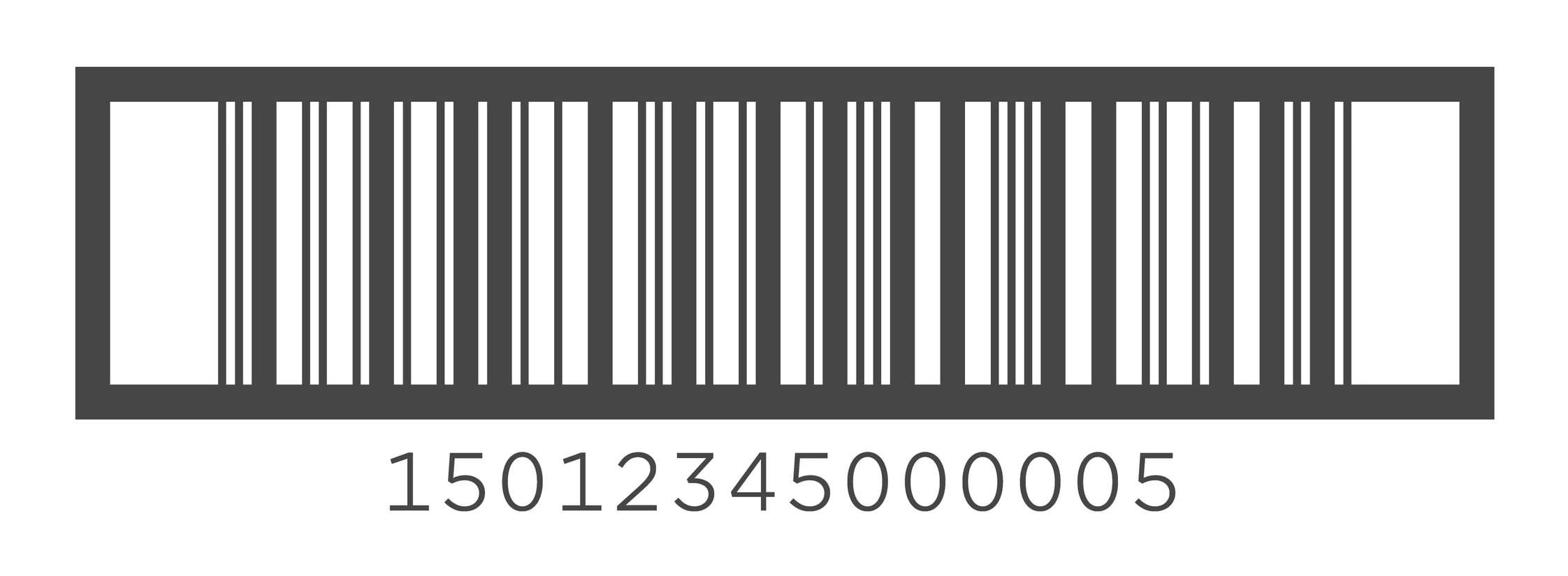Barcodes for cases
You have a few options when choosing the barcodes for your cases, all of which use the Global Trade Item Numbers (GTINs) we licence to you. It’s important to make sure you choose the correct barcode – and that will depend on where they will be used and contents of the casing.
In this article, we will explain how to create a barcode for your cases, and what options you have depending on your needs and preferences.
Traded units also sold in store
If you have an item that is both a traded item and is also going to be scanned at point of sale, it needs to have an EAN/UPC barcode on it. In the UK, this is likely to be an EAN-13. Examples of this type of product include big cases of soft drinks and large bulky items such as washing machines.
On this sort of item, the EAN/UPC barcode needs to have an X-dimension of at least 0.495mm (150% magnification factor).
Some producers also use an ITF-14 on the packaging alongside the EAN, depending on their packaging type (see below section) or their trading partner requirements.
If you are adding an additional ITF-14 barcode, it is important that it encodes the same GTIN as in the EAN barcode, but with a leading zero in front of it. The zero acts as a padding character to enable the GTIN-13 to fit the ITF-14 barcode. The ITF-14 can’t be scanned at the point of sale – it is just scanned in warehouses, distribution centres, etc.
It is important to have different GTINs for each of the packaging levels. E.g., the GTIN on a case of 24 cans of coke needs to be different to the GTIN on the individual cans contained.
Traded units used in general distribution
If traded units/cases are not going to be scanned at the point of sale, there are two more GS1 barcodes that would meet your needs. The ITF-14 is great for printing directly on poor quality material, such as cardboard boxes, and the GS1-128 barcode enables you to encode extra information about the traded unit, such as best before dates and batch numbers. Very handy for traceability purposes.
ITF-14 barcodes
These are used when printing directly on to fibreboard outer cases but can also be printed on labels. These barcodes are larger than the standard EAN or UPCs, making them easier to see in a warehouse environment.
If you print the barcode on the case directly, we recommend that you print it twice (on one short side and on one long side) – but if a label is used, one barcode is sufficient.
ITF-14 barcodes should have the ‘bearer bars’ - the thick box around the ITF-14 symbol. The bearer bar helps to balance the pressure from the printing plate over the whole symbol area and to improve reading accuracy by lowering the chance of errors or incomplete scans that may happen when a slanted scanning beam goes in or out of the barcode through its top or bottom edge. The bearer bar is required unless it is impossible to print it (in which case reading quality will suffer).
The bearer bar may extend above and below the Quiet Zone. However, it is not mandatory to print the vertical sections of the bearer bar.

ITF-14 barcode should also be in picket fence orientation (horizontal) on the traded unit.
GS1-128 barcode
GS1-128 barcodes, together with the Application Identifier (AI) standards, enable you to provide additional information about the traded unit alongside the GTIN. For this reason, the GS1-128 can be beneficial to traceability across the supply chain. It can be used across many industries and use-cases and is often requested by retailers for traded units of short shelf-life products (less than 42 days).
Examples of data that can be encoded using Application Identifiers, include:
Dates (expiry, best before, packaging)
Batch numbers
Country of origin

A GS1-128 barcode encoded with GTIN (01), use by date (17) and batch (10).
Both the ITF-14 and GS1-128 require the GTIN to be in a 14-digit format. If you are using a GTIN-14 to identify the traded unit, it seamlessly aligns with the requirements of both the ITF-14 and GS1-128 barcodes. However, if you are using a GTIN-13 to identify the traded unit, you would need to prefix it with a zero to make it fit (see example below).

Variable measure product
If your cases contain catch weight items (items that do not have a predefined weight), then they can be identified with a GS1-128 barcode that incorporates the total net weight of the contents.
Other variable measures such as length, area and volume can be shown using different application identifiers, but weight is the most common measure used in the UK.